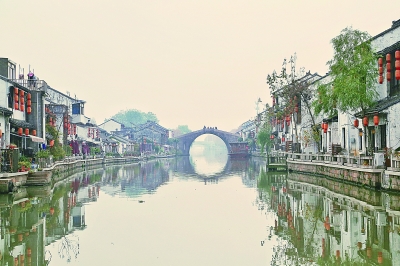Report on China’s Grand Canal development released

The Qingming Bridge historic and cultural block along the Grand Canal in Wuxi, Jiangsu Province. (GUANGMING DAILY)
The Bluebook for China’s Grand Canal: Report on China’s Grand Canal Development (2018) was released at a conference and symposium co-hosted by the Grand Canal Research Institute at Liaocheng University, the World Historic and Cultural Canal Cities Cooperation Organization, and Social Sciences Academic Press (China). The first annual report on the development of China’s Grand Canal, it examines and summarizes the water conservation project, transportation, tourism development, academic culture, heritage protection, the construction of a cultural belt, and the city and town development along the canal.
Using official statistics and on-site investigation data, the report analyzes the development of the Grand Canal in different sectors since it was listed as a World Heritage Site on June 22, 2014. Altogether, 27 sections and 58 historical sites of the canal, which are scattered in 27 cities and six provinces, have been placed on the UNESCO’s World Heritage List.
“The cultural belt of the Grand Canal can be defined as a strap of banded functional area that is guided under the principle of protecting, inheriting and utilizing the canal culture, that is based on existing waterways, ancillary facilities, and other relevant remains, that aims at the tangible and intangible heritage protection of the canal, and that relies on the cultural industry and undertakings derived from the canal’s development, said Wu Xin, director of the Grand Canal Research Institute. Mainly characterized by the originality of its strategic development, its large scale, and diversity in the forms of exhibition and utilization, the canal’s cultural belt construction is what the building of linear corridor of heritage along the canal intrinsically demands, Wu said.
The report found that the government departments at all levels have promulgated various kinds of the plans, regulations and laws concerning heritage protection, tourism planning, watercourse management, transportation and other aspects, which provide the targets and frameworks for the Grand Canal’s cultural protection and use as well as regional economic development. The cultural belt of the canal has embarked on the fast track of development, and its construction has formed certain basis and scale in many cities and towns along the canal.
Zhang Yuejin, director of the Expert Committee of the World Historic and Cultural Canal Cities Cooperation Organization, said that six of the world’s canals, including China’s Grand Canal, have been included in the World Heritage List. The Grand Canal of China still undertakes the functions of transportation, water conservancy, irrigation and South-to-North water transfer, playing an important role in improving the ecology, beautifying the environment, breeding culture and fostering communication.
The report also summarized and reviewed the academic research in terms of canal study in 2016 and the first half of 2017. Between January 2016 and June 2017, as many as 23 books were published in China associated with canal study, and more than 300 related academic papers were published involving heritage protection, science and technology concerning shipping, tourism development, image and file preservation, legends and oral histories of the canal. In addition, a number of academic conferences on canal study from different perspectives were held, reflecting the increasing popularity of the field. From 2016 to 2017, more than 10 national research projects about canal study were approved.
(edited by BAI LE)
